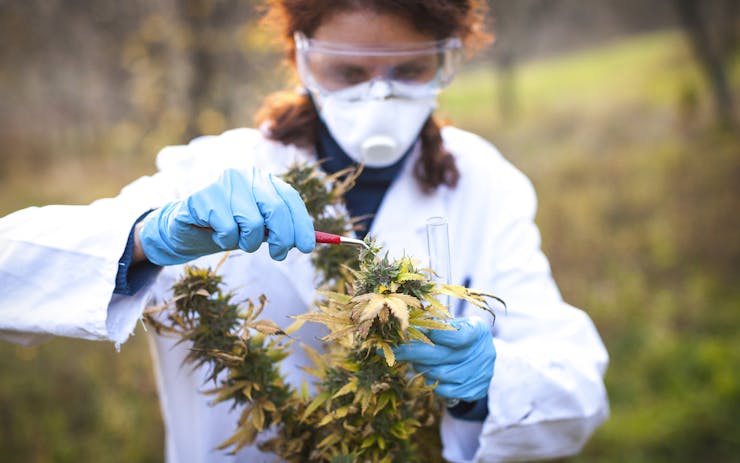During a discussion at a New York conference in October, Kevin Chen described something so esoteric, so innovative within the cannabis industry, that New Scientistlater published a story about it.
'Cellular agriculture will be much more efficient than growing plants.'
What Chen described was cellular agriculture, which uses genetic modification to craft products with certain amounts of specified cannabinoids. Proponents have been applying this process elsewhere to uncured meats, while innovators within the cannabis industry espouse another potential target: to efficiently develop products rich in THC, CBD, or other cannabinoids, tailored to treat medical conditions and serve the recreational market with reliable, consistent ingredients.
The cannabinoid CBDV (cannabidivarin) has particularly received attention recently for its potential to treat patients with epilepsy, for example, via cellular agriculture. Traditional cannabis farming cannot yield enough CBDV, experts say, but cellular agriculture could.
“There’s enough groups working on this now that cellular agriculture is going to have a big role in this industry,” said Chen, president of Hyasynth Bio, a Montreal company that conducts cellular agriculture primarily for medical cannabis product development. “It is going to be that much more efficient than growing plants.”
Using Chunks of Cannabis DNA
Cellular agriculture is a nuanced, complicated process. Defined by New Harvest (which held the October conference to discuss and promote cellular agriculture) as “the production of agricultural products from cell cultures,” experts compare cellular agriculture to the decades-old process of creating insulin.
Cultivators take the DNA of a specified cannabinoid and recreate it in a different form. To cultivate CBDV, for example, Hyasynth “added the chunk of cannabis DNA that codes for CBDV into yeast DNA, which turns the yeast into CBDV production plants,” reported Canna News.
“We have been working on [cellular agriculture] for three or four years, and it’s generally quite difficult,” Chen said, citing high risk factors and variable techniques with experiments — as well as “a lot of genetic modification.”
Achieving Precise Amounts of Cannabinoids
But the fruits of such labor include products with the precise amounts of the specific cannabinoids cultivators and consumers want—making cellular agriculture especially a potential boon for medical cannabis. “There’s definitely a need for high quality and larger-scale products,” Chen said. “We can’t always depend on a plant strain that’s going to grow exactly how you expect every time.”
Cellular agriculture, like biosynthesis more broadly, also suits pharmaceutical companies that “need purity in these products,” said Eric Adams. Adams is the CEO of one such company, InMed Pharmaceuticals, based in Vancouver, B.C. The process “lets us control these rare cannabinoids and make them pesticide-free.”
“You need a cost-effective source and that’s where cellular agriculture could come in,” said Avtar Dhillon, board chairman for the medical cannabis company Emerald Health Therapeutics, based in Victoria, B.C. The idea that “a molecule coming from a plant could be produced synthetically or biosynthetically,” Dhillon added, “has far-reaching implications.”
“Anybody who is developing cannabinoids through any kind of regulatory process,” he said, will consider synthetic ways of manufacturing in the near future .
High-CBD products are being developed to treat inflammation and anxiety, for example, while insiders have hinted they are working on high-THC products to feed the surging recreational cannabis market. “The fastest-growing [market] segment are edibles, “ Adams said. “Here you can start with the ingredients you want and mix them more consistently.”
Focus on Medical Market
For now, at least, the bulk of cellular agriculture efforts are being directed at the medical market. Take CBDV, for example. A cannabinoid similar but not identical to CBD, it occurs only in small traces of certain strains. GW Pharmaceuticals is evaluating its ability to treat autism spectrum disorders and epilepsy, with the company recently beginning Phase 2 of an epilepsy clinical trial, according to its website.
“There is early evidence [ that CBDV] could be beneficial” in treating neurodegenerative disorders, said Dhillon, a former family medicine physician.
“There is huge potential for having particular cannabinoids acting on a multitude of disorders,” Dhillon added. “What we don’t know is will that be achieved by one cannabinoid or will we need a mixture of cannabinoids?”
3 to 4 Years Away
The market is “at least three-to-four-years away” from having synthetic cannabinoid products approved for medical treatment, Dhillon noted. “We are not going to see the industry switch over from farming to cellular agriculture overnight.”
But over many nights, if advocates are correct, one day this new scientific process may become a lot more common.
“We are definitely dedicating a substantial amount of resources behind development,” Adams said. “We are aggressively pursuing it.”





